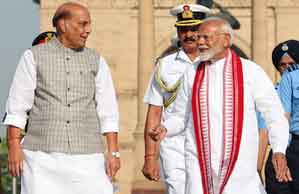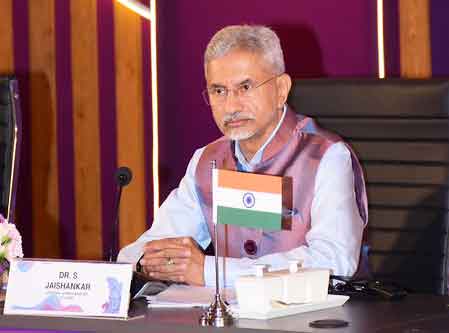The unprecedented face-off at the Line of Control (LoC) and the border areas, after India destroyed nine terrorist camps in Pakistan-occupied-Kashmir (PoK) and Pakistan, saw a barrage of missiles, drones and other munitions being fired from across the border on Thursday night, but India intercepted and shot all of them in the air. Not a single missile could land on Indian territory, failing to reach intended targets.
Days ago, the Indian armed forces carried out targeted and precision strikes on key terror hubs across the border, hitting and destroying them with clinical efficiency.
This sent a clear message to the world – India was not only securing its skies but also had the capability to breach enemy airspace with clinical precision.
The credit for India’s overhauled air defence ecosystem goes to the Narendra Modi government, which has kept its thrust on revamping the security apparatus by phasing out the depleting war reserves and inducting a new, world-class arsenal.
The Russian S-400 systems and Rafale jets, largely, accounted for India’s success in countering Pakistan’s multi-pronged attack.
Interestingly, both of these became part of India’s defence system under the NDA government and that, too, apparently at the insistence of Prime Minister Narendra Modi.
The rapid, coordinated response that the armed forces showcased was because of the air defence ecosystem — built painstakingly over the past 11 years under the Modi government.
The Integrated Counter-Unmanned Aerial System (UAS) Grid, S-400 Triumf systems, Barak-8 missiles, Akash Surface-to-Air Missiles, and DRDO’s anti-drone technologies came together seamlessly to create an aerial shield that thwarted all Pakistani attempts to hit military installations in India.
When India hit terror hubs under 'Operation Sindoor', the security forces destroyed a Chinese-supplied HQ-9 air defence unit in Lahore, also damaging key radar infrastructure.
Here is how India fortified its air defence ecosystem.
The level of preparedness didn’t materialise overnight. Since 2014, the government under PM Modi has systematically upgraded India’s air defence architecture, made key Defence acquisitions and modernised its warfare.
Key acquisitions:
In 2024, Man Portable Counter Drone Systems (MPCDS) were installed by the Army to jam and disable hostile UAVs.
In 2018, a Rs 35,000 crore deal was struck for five S-400 Triumf squadrons. Three squadrons are now operational along the borders with China and Pakistan.
In 2017, India got Barak-8 Medium-Range Surface-to-Air Missiles (MR-SAM) as part of a $2.5 billion deal with Israel. They are now guarding frontline bases like Bhatinda.
The induction of indigenous Akash missile batteries and DRDO-developed counter-drone systems gave more ammo.
Indian Tech in Modern Warfare:
Loitering munitions (kamikaze or suicide drones) were ordered in 2021 and are now manufactured in India. These drones executed simultaneous, precision strikes across sectors, taking Pakistan’s defences by complete surprise.
Additionally, Israeli-origin Harop drones — now locally built — were deployed to target and destroy air defence assets in Karachi and Lahore.
These platforms, combined with the strategic deployment of Rafale fighter jets equipped with SCALP and HAMMER missiles, demonstrated India’s capability to project power with surgical precision.
Notably, 'Operation Sindoor' sent a clear message to the world that India is not just capable of defending its skies, it now controls them.
And, it is the result of the consistent and persistent approach of the government to build a resilient, multi-layered ecosystem.






Omar Abdullah lauds armed forces for swift response to cross-border aggression
Jammu and Kashmir Chief Minister Omar Abdullah on Friday rushed to Jammu to take stock of the situation following heightened India-Pakistan tensions, drone attacks and intense shelling in border districts. With airports closed, the Chief Minister proceeded to Jammu by road.
Operation Sindoor: How India aced diplomatic battle after hitting terror hubs inside Pakistan
As India decided to treat the Pahalgam massacre as the last straw and made up its mind to hit back hard on terror, the cynics and naysayers were worried about the diplomatic fallout and also expressed fears of India’s ‘isolation’ for stepping up the heat at the border.
High security along B'desh borders with NE states amid India-Pak tensions
Amid ongoing India-Pakistan tensions, security along the northeastern states' borders with Bangladesh was further tightened, and numerous precautionary measures were taken, officials said on Friday.
MoS Defence Sanjay Seth meets President Putin, thanks Russia for support in fight against terror
Minister of State for Defence Sanjay Seth, representing India at Russia's 80th Victory Day celebrations marking the end of World War 2 in Moscow, also met Russian President Vladimir Putin during his visit.
Is NSA Ajit Doval on Facebook? PIB fact check exposes fake post
Pakistan's disinformation machinery has once again come under the spotlight, this time for targeting India’s National Security Advisor (NSA) Ajit Doval through a fake Facebook post. The post falsely claimed to quote Doval warning about an impending cyberattack from Pakistan.
American-Jewish community thanks India for eliminating Islamist terrorist Abdul Rauf Azhar
Operation Sindoor, targeting nine high-value terror locations in Pakistan and Pakistan-occupied Kashmir (PoK) also brought the much-awaited justice to friends and family of American-Jewish journalist Daniel Pearl.
IPL 2025 suspended for one week, new schedule and venues to be announced in due course: BCCI
The Board of Control for Cricket in India (BCCI) confirmed that the IPL 2025 has been suspended with immediate effect, albeit for one week in the wake of the India-Pakistan border tensions.
In setback to Pakistan, World Bank distances itself from Indus Water Treaty
In a major setback to Pakistan, the World Bank made it clear on Friday that it has no role to play in sorting out matters related to the Indus Water Treaty, which India has suspended following the terror attack in Pahalgam, which claimed the lives of 26 tourists.